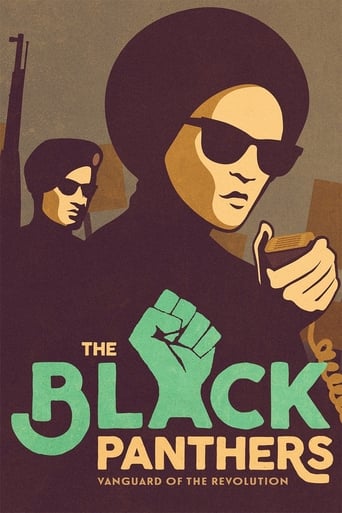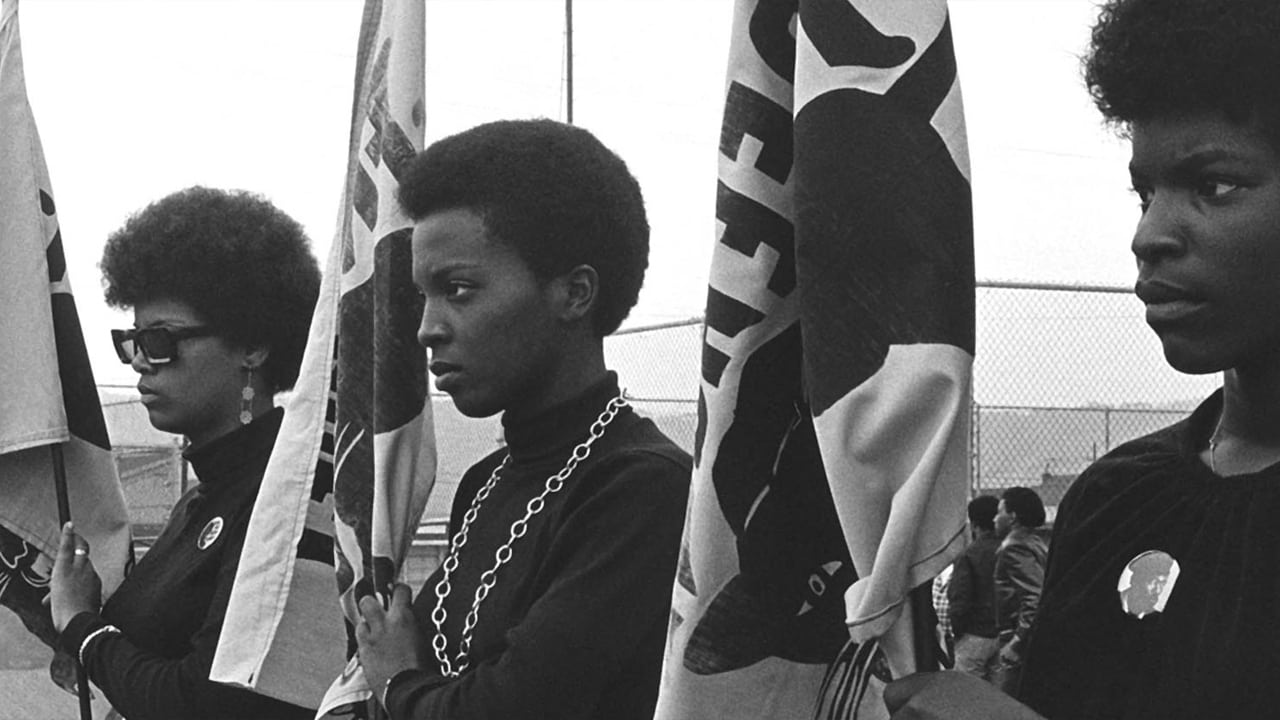Goingbegging
This is a film to rally the faithful. But it needs more than that to justify the sub-title 'Vanguard of the Revolution', when we're looking at a movement that was fatally split in half through conflict between its leaders, in the style of most far-left groups, and which has effectively ceased to exist. "We were making history" enthuses one supporter. Hmm...True, director Stanley J. Nelson Jr. has made quite a strong case that the split was skilfully and secretly provoked by the FBI under J. Edgar Hoover, who openly declared the Panthers to be a prime threat to national security. But there's nothing new about divide-and-rule, and a united party leadership ought to be proof against it.One philosophical survivor of the movement sums it up well in an ironical post-mortem. "The strength of the Panthers was its ideals and its youthful enthusiasm. The weakness of the Panthers was its ideals and its youthful enthusiasm." At times, the movement can look like a dress-rehearsal for the Nation of Islam, with its solemn drill parades. At others, it just looks like hooligans on the rampage. Those seeking to be convinced by cogent and consistent argument are liable to come away disappointed. "I'm important enough to be arrested. I'm a real Panther now." says one of its senior officers, as though he was fourteen years old. And when Bobby Seale fails to be elected mayor of Oakland, the Panthers cry "He's going to be OUR mayor!" Finally, you're better not looking too closely at Cleaver and Newton. Especially Cleaver, who went careering round in circles, and ended up as a right-wing Republican, voting for Reagan.
Red-Barracuda
This is the story of the revolutionary group, The Black Panthers. Formed in the late 60's, they were an anti-capitalist, left wing militant group formed by disenfranchised black citizens originally in Oakland, California. Their formation was a result of the continued harassment and police brutality their people suffered in American cities at that time. It was a separate incarnation from the Civil Rights movement which had been specifically about redressing the actual lack of equal rights for black people in the American southern states. The Black Panthers were formed to stand up for blacks in the more 'equal' urban areas who were still put upon by the white authorities and who still suffered much racism. They famously had an image of openly bearing arms and their overall approach was of a more confrontational style than that preached by Martin Luther King. Just as important, their look became very chic, dressed all in black, wearing berets, leather jackets and shades, they also sported afro haircuts in an unashamed way for the first time in contemporary America. The idea was to visually show that black was beautiful in its natural form. The look certainly resonated with images of the group making the front covers of various magazines; it remains iconic to this day.The film is made up by a combination of extensive archive footage from the time and current interviews with past members of the group. It tries to understand some of the motivations and ambitions of the group, while looking at some of their opponents such as the head of the FBI, J. Edgar Hoover who seemed quite obsessed with eradicating the group. In one telling clip he even states that he doesn't consider the concept of justice as being all that important and that law and order was what he was all about. So it's perhaps not so surprising that this philosophy led to an infamous incident where a prominent member of the Black Panthers was murdered by the Chicago police, an event that is thought to be related to the FBI chief in some way. For some reason though, despite the very interesting subject matter and the dramatic backdrop that the late 60's / early 70's America provides, I felt something lacked from this telling of the story. It never seemed to be as dynamic as it should be and while I learned a few things, it never felt as engaging as it should be and so I left a bit disappointed on the whole. This is certainly an interesting subject though and it does cover quite a lot of ground but I felt it could have been more dynamically told.
David Ferguson
Greetings again from the darkness. Black lives matter. We hear the phrase frequently these days, and director Stanley Nelson (Freedom Summer) takes us back 49 years to the beginning of the Black Panther Party, and then walks us through the rise and fall. Rather than the usual textbook approach that focuses on the famous photos of angry black men wearing leather jackets and berets while toting firearms, this is a much more comprehensive look at the complexities of the organization and its members.The familiar names of the Black Panther leaders include Huey Newton, Bobby Seale, Eldridge Cleaver, Kathleen Cleaver, Elaine Brown and Fred Hampton. Despite the fact that first hand interviews weren't possible with the big three – Newton and Cleaver are no longer living, and Seale declined the opportunity, there are some fabulous video clips and photographs, many of which have been rarely seen.It's the interviews with former Black Panther members that provide the most insight. Their stance is that the original plan was a non-violent approach to bring attention to police brutality and the lack of equality in Black America. Many social programs were started to assist kids and the poor, but things turned more aggressive when the passive approach didn't yield the desired results. Newton studied the laws and realized open carry was permitted on public property, and that's where most of the famous photos originated.The segment on J Edgar Hoover's counterintelligence plan for the FBI to do what was necessary to prevent the expansion of the Black Panthers is one of the film's best. Hoover even described them as "the greatest threat to the internal security of the country" (yes, this was during the Vietnam War). He was especially concerned about the rise of a "messiah", and that led to what most consider the assassination of Illinois chapter leader Fred Hampton while he slept.Oakland is widely accepted as the central hub of the Black Panthers, and it was surprising to learn that "most" members were teenagers and a majority were female. The interviews with the former members are fascinating and void of any pomp or bluster
just matter-of-fact recollections. What really stands out is just how media savvy the leaders were. They understood how to get headlines and bring attention to the issues.We also learn that Jane Fonda hosted fundraisers and meetings, and we see a clip of Marlon Brando supporting the Black Panthers. These celebrities brought legitimacy to the organization, but didn't stop the fracture that occurred when Huey Newton and Eldridge Cleaver began feuding over the best direction. Seeing clips of Bobby Seale running for Mayor of Oakland in 1972 certainly brought a contemporary feel, as the black voter registration drives continue to this day.As one of the former members states "making history" was "not nice and clean". We learn that more than 20 former Panthers are still in prison today, and the parallels between the mid-60's and the movement for equality today are undeniable. Director Nelson offers an informative education without preaching or romanticizing the Black Panthers.
jakob13
When was the last time a state legislature infringed on the right guaranteeing a citizen's right to openly carrying a gun? Well, Stanley Nelson's excellent documentary The Black Panthers answers that question. Imagine then governor Ronald Reagan and the conservatives in the California legislature, won over temporarily, to the idea of gun control by the sight of the Black Panther Party marching into the statehouse in Sacramento, carrying loaded shotguns and rifle, as state law and the Constitution allowed. Challenging political order and mayhem, who were this new breed of "Negroes," dressed from head to foot in black? Why did they did they project an image of militancy and armed purpose? Today's headline grabbing evidence of police brutality and racial injustice to black people have not spawned the same response that gave birth to the BPP in response to oppression and marginalization, as #-tag Black Lives matter. Why? Nelson has recovered through use of newsreel, take, take outs from Eye on the Prize and interviews with aging ex-Panthers, to dust off 50 years of ignorance. We are transported to another galaxy of time. It was an age of war and revolution. Algeria, Cuba, Vietnam. It was also an age of turmoil that broke the back of colonial domination and smashed in the chains of vote denial in the American South, albeit through non-violence, as Ava DuVernay's striking film Selma serves as clear evidence. But what worked in the South couldn't and wouldn't in the North because voting rights were not the issue. Racial injustice and the ever-present violence and brutality of the police were. (Chester Himes' "Coffin Ed and Grave Digger Jones" mysteries, recreate life in urban ghettos.) The Black Panthers gives body to the logic of a society that marginalized and trivialized and isolated a third of its citizens through naked violence. And, as such, it birthed the BPP in Oakland, California in 1966. The choice of the symbol of the Black Panther is significant. In Mayan culture, the animal, a fierce fighter, is a totem of aggressiveness and power. It does roar. It won't strike unless provoked. The outbreak of the Panthers on the scene was merely an acceleration of a process of political awakening that had been building for some time at home and abroad. Stokley Carmichael had called for Black Power in the heart of Mississippi. And James Baldwin's 1963 The Fire Next Time, according to the Negro Spiritual, promised a conflagration as the wide range of injustices morphed into a call for political action. Furthermore, the BPP saw itself in the vanguard of sweeping change. To exploit the fever of heated times, it harnessed revolutionary gestures and emotions. So, six young men began organizing activists to confront the local police with guns. They spurned the appeal of Nation of Islam that preached self-segregation. They also rejected the belief that society could be made better by the change of the human heart. The zeitgeist of revolution had taken hold. If the US was fighting for "democracy and freedom and liberation from Communism" in Vietnam, the BPP figured that they were going to protect and fight for the interests of their own people that Washington sorely neglected. So, they took up the gun; they didn't confront the police but stayed at a respectful distance, to see that blacks weren't abused. Like their namesake, they remained vigilant unless otherwise provoked. The adoption of the powerful image of a gun had a revolutionary source: after all Mao did affirm "power grows out of the barrel of a gun?" The Party had an all-embracing slogan Power to the People. It had an ideology--and a 10-point program What We Want Now! It had a newspaper; it had revolutionary art; it had a "military force," and above all, it had what Carlyle called: beginners, men who had qualities to serve its ideas and ideals in the persons of Bobby Seale, Hotspur-like Huey P. Newton, and Eldridge Cleaver. Government repression and internal backstabbing over who upheld the purity of the BPP helped destroy the party is this gripping film.


 AD
AD




